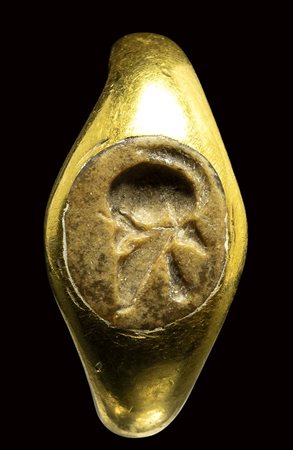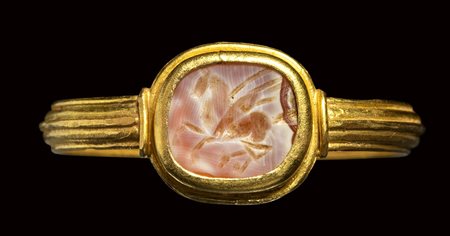ASTA 107 - Glittica
-

Lotto 97 A roman jasper intaglio mounted in a later gold ring. Helmet.
1st - 2nd A.D.
The crested helmet is formed with a wild boar’s head. The gold mounting is with rounded hoop, flatten within and extending at the shoulders with an oval bezel. Signs of use on the surface of the stone.
Stone 9 x 11 mm; ring size 17 x 19 mm ; 8,03 gr
-

Lotto 98 A late roman gold signet ring set with a carnelian intaglio. Greek letters.
Early 3rd century A.D.
This hoop, expending suddenly at the shoulders, above a thin elongated almond-shaped box setting containing a carnelian intaglio with greek letters (probably a name) : Α P Ι A Ν Ο C . Arianos is a fairly common Greek name; there is a Greek general by that name and an early Christian saint. Damages on the edge of the box setting. Slight chip on the edge of the intaglio.
Stone 6 x 13 mm; ring size 12 x 14 mm; 2,62 gr. -

Lotto 99 A roman burnt agate intaglio set in a gold ring. Pegasus.
2nd century A.D.
Thick hoop, facetted; oval box setting with an burnt agate intaglio depicting Pegasus, the winged horse, flying left.
Stone 7 x 8 mm; ring size 18 x 20 mm; 3,10 gr. -

Lotto 100 A roman carnelian intaglio set in a gold ring. Allegorical emblema.
2nd century A.D.
Hoop rounded without and within extending on the shoulders with embossed angles. The box-setting made of two oval levels containing a carnelian intaglio depicting a cornucopia, a basket (kalathos), a mouse (?) holding a grape, a branch. Allegory of abundance and prosperity. Slight wears marks on the surface of the stone.
Stone 7 x 9 mm; ring size 17 x 18,5 mm; 7,04 gr. -

Lotto 101 A roman carnelian intaglio set in a gold ring. Dextrarum Junctio.
2nd century A.D.
The stone is engraved with two clasped hands (dextrarum junctio), with two cornucopiae, ear of corn, and poppy flower. In the center, emerging, a caduceus. Allegory of abundance and luck in union.
The gold mounting is massive with rounded hoop, and large oval bezel. Sign of use on the surface of the stone and wear marks on the surface of the mounting.
Stone 8 x 10 mm; ring size 20 x 23 mm; 4 gr. -

Lotto 102 An italic carnelian intaglio. Dextrarum junctio.
1st century B.C. - 1st century A.D.
The scene depicts two hands clasping and holding poppy flowers and ears of corn. Wear marks.
12x17x4 mm -

Lotto 103 A roman carnelian intaglio. Goat with thyrsus.
1st century A.D.
The goat is facing left , behind her the thyrsus. Groundline. Dionysiac symbolic emblema.
8x10x3 mm -

Lotto 104 A roman rock crystal intaglio. Fly.
1st - 2nd century A.D.
The insect is seen from above and is engraved on a lenticular gem of beautiful brightness and transparency. Slight wear of marks.
Diam. 12 x 4 mm. -

Lotto 105 A late roman gold ring set with a lapis lazuli intaglio. Scorpio.
3rd century A.D.
With rounded hoop, extending on high-raised shoulders and with a hollowed neck. The high raised rectangular box setting is set with a lapis lazuli intaglio depicting a naturalistic scorpio. Possibly with astrological meaning. Wear marks.
Stone 5 x 6 mm; ring size diam 15 mm; 1,80 gr. -

Lotto 106 A roman gold ring engraved with palm branch.
2nd century A.D.
With rounded hoop, flat within, extending with a broader bezel, engraved with a stylized palm branch.
Parallel: British Museum, inv. AF.208
ring size 18 x 19 mm; 1.90 gr. -

Lotto 107 A roman burnt agate intaglio. Warship.
2nd - 3rd century A.D.
Warship, with rostrum and aplustre, facing left. Above, three stylized hoplites armed with shields and spears. Burnt stone.
10 x 12 x 2 mm. -

Lotto 108 A roman amethyst intaglio. Warship.
1st century A.D.
Trireme sailing left, the pars lowered, billowing sail by the wind, the waves finely depicted. The iconography refers to early roman coinage as the depictions of Pompey naval victories on silver denarii. Double cabochon. Attractive color of the stone.
10x14x5 mm
-

Lotto 109 A roman agate intaglio. Trophy.
2nd century A.D.
The military trophy consists of a cuirass on a pole, to which two round shields, a helmet, three spears and two swords are attached; below, two shields. Groundline. Subject also present in the coeval coinage. Slight wear marks.
14 x 17 x 5 mm. -

Lotto 110 A roman garnet intaglio. Jug.
1st - 2nd century A.D.
The oval elongated cabochon stone is engraved with a trifoiled jug, the beak towards left, with deep carved globular body and high foot. Groundline. Mirror polishing and wear marks. Beautiful red color.
10x15x5 mm -

Lotto 111 A roman carnelian intaglio set in a gold ring. Allegory of Zeus Sarapis.
2nd - 3rd century A.D.
Above is a bust of Sarapis; below is an eagle between two standards with victories. Groundline under the eagle. Large chip on the edge. Slight wear marks. Parallel: G. M. A. Richter, Catalogue of Engraved Gems, Greek. Etruscan and Roman, The Metropolitan Museum of Art, NY, p. 260 n. 259.
Stone 13 x 18 mm; ring size diam. 19 mm; 12,42 gr. -

Lotto 112 A roman carnelian intaglio. Sea scene.
2nd - 3rd century A.D.
Rare and unusual representation of a character with an oar (or rudder, or scepter?) that comes out of a shell. Small chips on the edge. Probably from the marine Thiasos of Poseidon.
8 x 9,5 x 3 mm. -

Lotto 113 A roman carnelian intaglio. Gryllos.
2nd century A.D.
The hybrid creature is characterized by a bust of Athena whose helmet is made up of two joined heads of Silenus; on the shoulder, a theatrical mask and on the chest an erote mask. Interesting apotropaic composition. Attractive color of the stone.
9 x 11 x 4 mm. -

Lotto 114 A roman red jasper intaglio set in an ancient gold ring. Gryllos.
2nd - 3rd century A.D.
The hybrid creature is composed of an eagle's body, to which two heads are joined. The head in front can be identified with young a satyr, while on the back a Silenus's face. Behind, a spear. Probably a military apotropaic emblem. Ancient gold ring in good condition.
Stone 11 x 14 mm; ring size 16 x 19 mm; 5,49 gr. -

Lotto 115 A roman red jasper fragmentary intaglio mounted on a modern gold ring. Gryllos.
1st - 2nd century A.D.
The scene depicts two bearded heads (one partially missing) joining at the neck. The faces are characterized by long beard and shaved skulls with only some long hair on top dividing the two heads. The left face shows strong features— raised eyebrow, strong look with small lidded eye, aquiline nose, full lips.
The 18k gold mounting has a massive rounded hoop with broader shoulders. Rounded box-setting with circular frame. Wear marks.
Stone 7 x 8 mm; ring size 15 x 16 mm; 2,12 gr. -

Lotto 116 A roman red jasper intaglio mounted in a gold ring. Gryllos.
2nd century A.D.
Plain hollow hoop, expanding into broad shoulders and oval bezel with an oval red jasper intaglio: gryllos formed with a corinthian helmet with two male heads and bust of Minerva turned left.
Wear marks on the mounting.
Stone 7 x 9 mm; ring size 12 x 15 mm; 13,53 gr. -

Lotto 117 A roman carnelian intaglio mounted in a modern gold ring. Gryllos.
1st - 2nd century A.D.
The scene depicts a gryllos with four conjoined heads; an elephant head with a caduceus in its trunk, a Silenus head with beard, a satyre head, and head of a woman. Apotropaic intaglio with reference to Africa. The modern gold mounting is made of rounded hoop with broader shoulders and oval bezel.
Parallels: Michael Carlos Emory museum, inv. 2008.031.112
Stone 10 x 13 mm; ring size diam. 17,5 mm; 13,12 gr. -

Lotto 118 A roman three-layered agate intaglio set in a gold ring. Gryllos.
3rd century A.D.
The hoop is elliptical and expands at the shoulders with pierced holes. The raised oval box-setting is set with a large agate intaglio with a gryllos. The creature is made with Silenus and horse heads, cock legs and lower body. Groundline. Slight wear marks. Slight chip on the edge of the stone.
Stone 11 x 15 mm; ring size 16 x 18 mm; 11,07 gr. -

Lotto 119 A roman carnelian intaglio. Sphynx.
1st - 2nd century A.D.
The hybrid creature is winged and facing left, with the right paw raised slightly. Interesting rendering of anatomical details. Groundline. Wear marks.
10x15 mm
-

Lotto 120 A roman carnelian intaglio set in a gold ring. Tryton.
2nd - 3rd century A.D.
The sea creature is facing left, and is characterised by a human bust on a sea horse body with a fish tail. With his right hand he holds a drap that swells with the wind; with his left a bowl. Slight signs of wear. The gem is mounted in a later ring characterized by a bezel with a twisted wire frame and two spheres to which the hoop is attached.
Stone 11 x 13 mm; ring size 16 x 17 mm; 5.13 gr.
